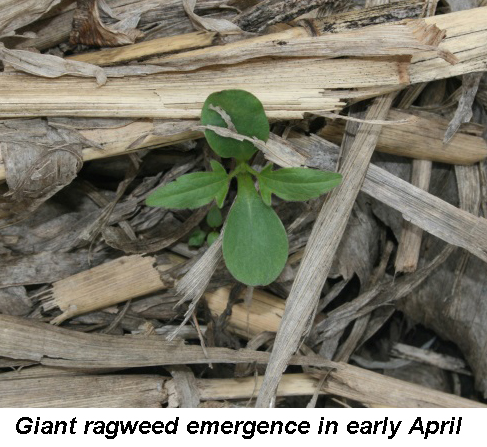
- Weather delays are resulting in larger, tougher weeds.
- Observe label plant back restrictions with growth regulator herbicides, or risk crop injury.
- Utilizing the new dicamba formulations on dicamba-tolerant soybeans allows for immediate planting and no required waiting period.
- Scout fields to determine the weed spectrum and the best herbicides to use.
While the old saying of "April showers bring May flowers" may hold true this season, our late April and early May precipitation is certainly slowing down many essential field operations in some geographies that have been repeatedly inundated with rainfall. The delay in herbicide burndown in our row crops can cause a few concerns, including larger weed size. As we all know, larger weeds are typically more difficult to manage. Increasing the herbicide rate to deal with these tall weeds is sometimes an option, but not always.
Due to the potential of a compressed planting window, we need to be conscious of the label restrictions for growth regulator herbicide applications prior to soybean planting. Planting of soybeans must be delayed at least 7 days after an application of 2,4-D ester (3.8 lb. ae) at the one pint per acre rate to reduce the risk for seedling injury. If increasing the application rate of 2,4-D ester beyond 1 pint per acre to manage broadleaves, soybean planting must be delayed 15 days.
With dicamba (4 lb. ae/gal), the delay in planting must be increased from 14 to 28 days when increasing the use rate from 8 to 16 oz./acre. In addition, the dicamba label requires 1" of rainfall prior to planting. When these waiting periods are taken into consideration, growers may choose to not increase their usual use rate for the growth regulator herbicides. Therefore, additional herbicides may need to be added to the tank to achieve satisfactory weed control of taller weeds.
The restrictions surrounding the required waiting periods for some growth regulator herbicides can be avoided when planting the new Roundup Ready 2 Xtend® Soybean technology with dicamba-tolerance. A benefit of this new technology is the ability to apply dicamba directly before or after planting when using the new dicamba products. To be clear, the only products that you can apply to dicamba-tolerant soybeans without the waiting period are XtendiMax™, Engenia™, and FeXapan™. The waiting period must be observed when using the older dicamba products, even on Roundup Ready 2 Xtend® soybeans.

Weed spectrum should also be considered when faced with the possibility of a delayed burndown application. In our no-till environments, marestail is quite large and will need more firepower than a glyphosate + growth regulator mix. While many of our winter annual weeds have been in the field since September, we also have some newcomers out there. Giant Ragweed is present throughout much of the geography and our "old friend" waterhemp is emerging where there has been significant degree day accumulation. Know what is in your field and what management options need to be implemented to provide adequate control.
Regardless of whether or not the weather will continue to delay burndown herbicide applications, it is still imperative that we first scout fields to determine the weed spectrum we will need to manage in these fields. We then need to be certain to follow herbicide label directions in order to successfully manage the weeds that are present in the fields, while ensuring limited crop phytotoxicity.
Contact your FS Crop Specialist for your agronomic information.